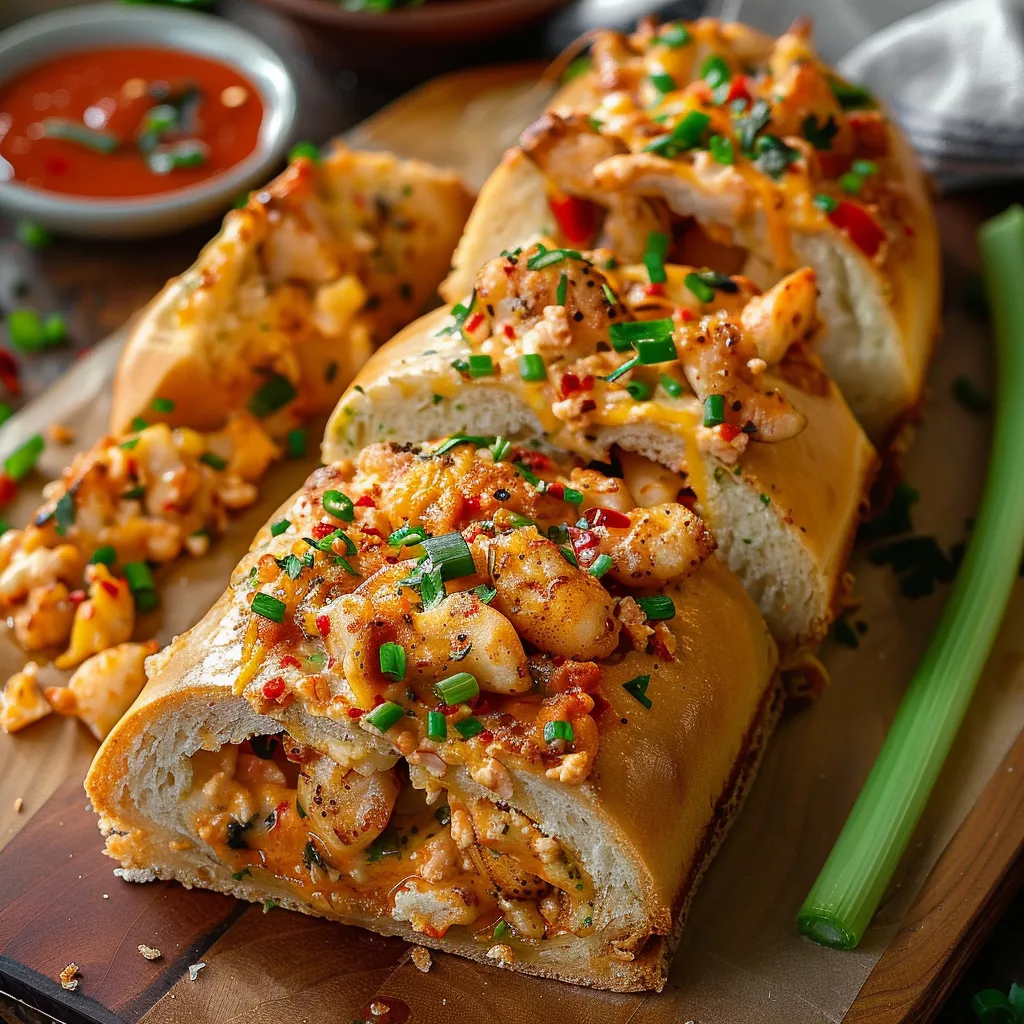 Pin to Favorites
Pin to Favorites
The moment you bite into a slice of Crawfish Bread, the flavors of Louisiana come alive in your mouth. The warm, crusty exterior gives way to a creamy, savory filling where plump crawfish tails mingle with the Cajun holy trinity of vegetables, all bound together by melted cheese and rich spices. This iconic New Orleans Jazz Fest favorite brings the spirit of the bayou to your table, transforming simple ingredients into something truly extraordinary that captures the essence of Louisiana cuisine.
At a recent family gathering, I served this alongside traditional gumbo, and my Louisiana-born uncle declared it "just like Jazz Fest" – perhaps the highest compliment possible for this iconic dish. The secret lies in cooking down the vegetable mixture until the liquid is reduced, concentrating the flavors before adding the crawfish.
Essential Ingredients and Selection Tips
- Crawfish Tails: Look for Louisiana crawfish if available, as they have the sweetest flavor. If using frozen, thaw completely and drain well to remove excess moisture.
- The Holy Trinity: The classic combination of onions, bell peppers, and celery forms the backbone of Cajun cooking.
- Cajun Seasoning: Choose a quality brand like Tony Chachere's or Slap Ya Mama for authentic flavor.
- Creole Mustard: This grainy, spicy mustard adds depth and tanginess.
- Cheese: A combination of sharp cheddar and monterey jack provides the perfect balance of flavor and meltability.
- Frozen Bread Dough: Rhodes or Ready-Dough brands work well. Thaw completely according to package directions.
 Pin to Favorites
Pin to Favorites
Detailed Cooking Instructions
- Prepare Your Workspace:
- Thaw the frozen bread dough according to package directions. Line a baking sheet with parchment paper and set aside.
- Create the Aromatic Base:
- In a large skillet, melt 4 tablespoons of butter and sauté 1 cup diced onion, ½ cup diced bell pepper, and ½ cup diced celery until softened. Add 2 minced garlic cloves and cook for 30 seconds.
- Incorporate the Crawfish:
- Add 1 pound of crawfish tails, seasoned with 1-2 teaspoons of Cajun seasoning. Cook until the crawfish is warmed through and most of the liquid has evaporated.
- Remove from Heat and Enhance:
- Transfer the mixture to a bowl to cool slightly. Stir in 1 tablespoon Creole mustard, ¼ cup mayonnaise, 2 tablespoons green onions, and 1 tablespoon fresh parsley.
- Add the Cheese:
- Fold in 1½ cups grated sharp cheddar and monterey jack cheese.
- Prepare the Dough:
- Roll out the thawed dough into a 12x16-inch rectangle, about ¼-inch thick.
- Assemble with Care:
- Spread the filling evenly over the dough, leaving a 1½-inch border. Roll up jellyroll style and pinch the edges to seal.
- Prepare for Baking:
- Transfer to a baking sheet, seam-side down. Make small slits on top to allow steam to escape. Brush with egg wash and let rest for 15-20 minutes.
- Bake to Perfection:
- Bake at 375°F for 25-30 minutes, rotating halfway through. The bread is done when golden brown and the internal temperature reaches 190°F.
- Rest and Serve:
- Let cool for 5-10 minutes before slicing into 1-inch pieces. Serve warm.
The Festival Connection Story
My first encounter with Crawfish Bread came at the New Orleans Jazz and Heritage Festival nearly fifteen years ago. The first bite, experienced amid the joyful chaos of the festival, created a sensory memory so powerful that making this recipe at home now conjures not just flavors but the entire atmosphere of that magical New Orleans afternoon.
The Home Kitchen Adaptation Journey
Bringing this dish into my kitchen required some adjustments. Using frozen bread dough provided the right texture, and reducing the vegetable mixture properly ensured the filling remained creamy without making the bread soggy.
The Gathering Evolution Experience
What started as a festival recreation has become a favorite for gatherings. Its make-ahead nature and versatility make it ideal for potlucks, game days, and casual dinners.
The Cajun Cooking Education
Mastering Crawfish Bread has taught me essential Cajun cooking techniques—properly sautéing vegetables, layering seasoning, and balancing flavors—that have improved my overall cooking skills.
The Seasonal and Local Adaptation
Depending on availability, I swap crawfish for lump crabmeat or shrimp, adjusting cooking times accordingly. Using seasonal vegetables ensures freshness and variation without straying from authentic Cajun flavors.
Preparing Crawfish Bread connects me to the vibrant food culture of Louisiana and the joy of festival eating. When I serve this bread, I'm sharing not just a delicious dish but a piece of New Orleans culture and the spirit of community that surrounds it.
 Pin to Favorites
Pin to Favorites
Frequently Asked Questions
- → Can I use frozen crawfish tails for this recipe?
- Yes, frozen crawfish tails work perfectly in this recipe. Thaw them according to package directions, and be sure to include any juice from the package as it adds flavor to the filling.
- → What can I substitute for crawfish if I can't find them?
- If crawfish aren't available, you can substitute with small shrimp (chopped into pieces), crab meat, or even diced cooked chicken for a non-seafood option. The flavor will be different but still delicious.
- → Can I make my own bread dough instead of using frozen?
- Absolutely! Any basic white bread or pizza dough recipe will work well. Prepare the dough through its first rise, then roll it out and proceed with the recipe as directed.
- → What is Creole mustard and what can I substitute?
- Creole mustard is a spicy, coarse-ground mustard popular in Louisiana cuisine. If unavailable, substitute with whole grain Dijon mustard or any spicy brown mustard.
- → Can I prepare this recipe ahead of time?
- You can prepare the crawfish filling up to a day ahead and refrigerate it. You can also assemble the entire bread a few hours before baking, keep it refrigerated, and then bring to room temperature for about 30 minutes before baking.
